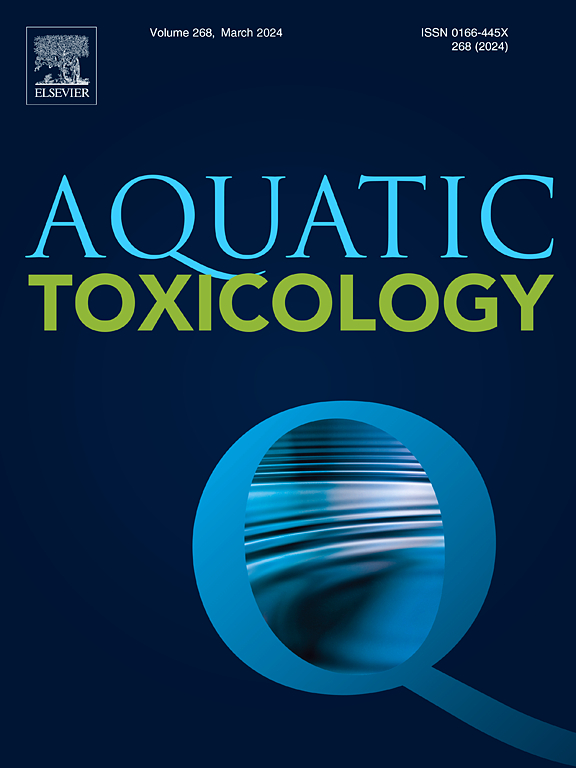Thyroid endocrine disruption effects of OBS in adult zebrafish and offspring after parental exposure at early life stage
IF 4.3
2区 环境科学与生态学
Q1 MARINE & FRESHWATER BIOLOGY
引用次数: 0
Abstract
As an alternative to perfluorooctane sulfonate, sodium p-perfluorous nonenoxybenzene sulfonate (OBS) has been widely used and caused ubiquitous water pollution. However, its toxicity to aquatic organisms is still not well known. Therefore, in this study, parental zebrafish were exposed to OBS at environmentally relevant concentrations from ∼ 2 h post-fertilization to 21 days post-fertilization (dpf) in order to investigate the thyroid disrupting effects in F0 adults and F1 offspring. Histopathological changes, such as hyperplasia of thyroid follicular epithelia and colloidal depletion, were observed in F0 adults at 180 dpf. In F0 females, thyroxine (T4) levels were significantly reduced in 30 and 300 μg/L exposure groups, while triiodothyronine (T3) levels were significantly increased in 3 μg/L exposure group. For F0 males, significant increases of T4 and T3 levels were observed, revealing the sex-specific differences after the OBS exposure. The transcription levels of some key genes related to the hypothalamic-pituitary-thyroid (HPT) axis were significantly disrupted, which induced the thyroid endocrine disruption effects in adult zebrafish even after a prolonged recovery period. For F1 offspring, the thyroid hormone (TH) homeostasis was also altered as T4 and T3 levels in embryos/larvae exhibited similar changes as F0 females. The transcription levels of some key genes related to the HPT axis were also significantly dysregulated, suggesting the transgenerational thyroid disrupting effects of OBS in F1 offspring. In addition, the decreased swirl-escape rate was observed in F1 larvae, which could be caused by disrupting gene expressions related to the central nervous system development and be associated with the TH dyshomeostasis. Therefore, parental OBS exposure at early life stage resulted in thyroid endocrine disruption effects in both F0 adult zebrafish and F1 offspring, and caused the developmental neurotoxicity in F1 larvae.
成年斑马鱼和后代在生命早期阶段亲本暴露于 OBS 后的甲状腺内分泌干扰效应
作为全氟辛烷磺酸的替代品,对全氟壬氧基苯磺酸钠(OBS)已被广泛使用,并造成了无处不在的水污染。然而,人们对其对水生生物的毒性仍不甚了解。因此,在本研究中,亲本斑马鱼在受精后 2 小时至受精后 21 天(dpf)期间暴露于环境相关浓度的 OBS,以研究其对 F0 成鱼和 F1 后代的甲状腺干扰效应。在180 dpf的F0成体中观察到组织病理学变化,如甲状腺滤泡上皮增生和胶体耗竭。在F0雌性暴露组中,甲状腺素(T4)水平在30和300 μg/L暴露组中显著降低,而三碘甲状腺原氨酸(T3)水平在3 μg/L暴露组中显著升高。对于 F0 雄性来说,T4 和 T3 水平都有明显升高,这揭示了暴露于 OBS 后的性别差异。与下丘脑-垂体-甲状腺(HPT)轴相关的一些关键基因的转录水平受到了明显干扰,这导致成年斑马鱼在经过较长的恢复期后仍会出现甲状腺内分泌紊乱效应。F1后代的甲状腺激素(TH)稳态也发生了改变,胚胎/幼体中的T4和T3水平表现出与F0雌鱼类似的变化。与甲状腺激素轴相关的一些关键基因的转录水平也出现了明显的失调,这表明 OBS 对 F1 后代的甲状腺具有跨代干扰效应。此外,在F1幼体中观察到漩涡逸出率下降,这可能是中枢神经系统发育相关基因表达紊乱所致,与TH失衡有关。因此,亲本在生命早期暴露于OBS会导致F0成年斑马鱼和F1后代的甲状腺内分泌紊乱,并引起F1幼体的发育神经毒性。
本文章由计算机程序翻译,如有差异,请以英文原文为准。
求助全文
约1分钟内获得全文
求助全文
来源期刊

Aquatic Toxicology
环境科学-毒理学
CiteScore
7.10
自引率
4.40%
发文量
250
审稿时长
56 days
期刊介绍:
Aquatic Toxicology publishes significant contributions that increase the understanding of the impact of harmful substances (including natural and synthetic chemicals) on aquatic organisms and ecosystems.
Aquatic Toxicology considers both laboratory and field studies with a focus on marine/ freshwater environments. We strive to attract high quality original scientific papers, critical reviews and expert opinion papers in the following areas: Effects of harmful substances on molecular, cellular, sub-organismal, organismal, population, community, and ecosystem level; Toxic Mechanisms; Genetic disturbances, transgenerational effects, behavioral and adaptive responses; Impacts of harmful substances on structure, function of and services provided by aquatic ecosystems; Mixture toxicity assessment; Statistical approaches to predict exposure to and hazards of contaminants
The journal also considers manuscripts in other areas, such as the development of innovative concepts, approaches, and methodologies, which promote the wider application of toxicological datasets to the protection of aquatic environments and inform ecological risk assessments and decision making by relevant authorities.
文献相关原料
公司名称
产品信息
百灵威
Heparin sodium
¥50.00~¥17449.00
 求助内容:
求助内容: 应助结果提醒方式:
应助结果提醒方式:


